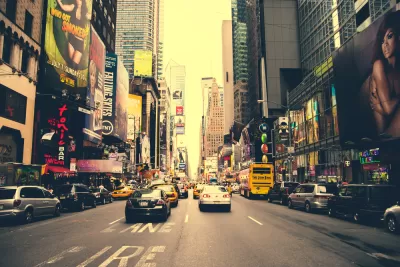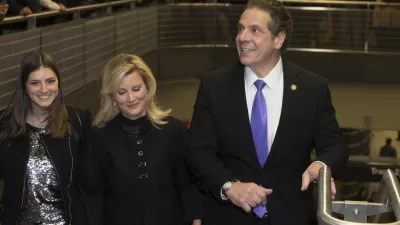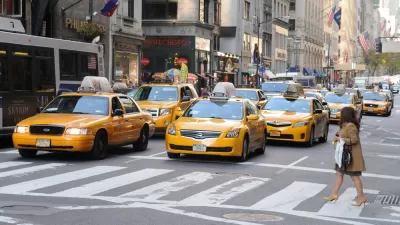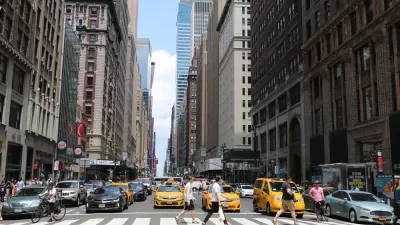Ten years after former NYC Mayor Michael Bloomberg's congestion pricing plan died on the state Assembly floor, expect to see a similar plan revived by Gov. Andrew Cuomo (D-N.Y.). New York Times metro reporter, Winnie Hu, explains why it never died.

"For decades, urban planners, economists, city officials and business leaders have revived again and again some version of a toll system both to manage the city’s worsening traffic and provide more revenue for public transit, writes Winnie Hu, a reporter on The New York Times Metro desk, focusing on transportation and infrastructure.
Now a state task force, called Fix NYC, has been assembled with the goal of developing another congestion pricing plan.[...]. Mr. Cuomo, after once expressing doubt about congestion pricing’s chances, is expected to unveil a plan early next year and make it a centerpiece of his legislative agenda.
Hu chronicles the movement to keep congestion pricing (also known as cordon pricing because tolls would apply toward a specific area, below 60th Street in Manhattan, much like London, Stockholm and the world's first scheme in Singapore) alive after former Mayor Michael R. Bloomberg's bill died in Albany after state legislative leaders refused to bring it to a vote (also posted here).
Congestion pricing “never really went away” said Mitchell L. Moss, the director of the Rudin Center for Transportation Policy and Management at New York University, noting that “it has an intrinsic appeal — a single solution that raises revenue, improves our environment and reduces congestion.”
Central to the effort were three congestion pricing advocates: Sam Schwartz, Charles Komanoff and Alex Matthiessen, brought together by transit advocate, Theodore W. Kheel, a prominent lawyer and labor arbitrator, to work on the issue. Kheel passed away two years after Bloomberg's bill died.
The three continued to promote Bloomberg's plan under the group, Move NY, but made some significant changes, like lowering tolls on some bridges while adding tolls to the untolled East River bridges, a key part of the plan. Funding was provided by The Rockefeller Foundation and the Nurture Nature Foundation, which was founded by Mr. Kheel.
Timing is right in 2017
This year, the state of decay of the New York subway became really evident. In June, Gov. Cuomo declared a "state of emergency" for the subway. [See Nov. 18 update by Brian M. Rosenthal, Emma G. Fitzsimmons and Michael Laforgia in the Times]. It was painfully clear that the subway needed modernization funds.
Also this year, Cuomo, a "car guy", took notice of improvements in bridge tolling technology. Having recently celebrated the opening of the long-stalled replacement of the Tappan Zee bridge, he recognized the benefits of electronic toll technology which enable toll collection via E-ZPass transponders and vehicle license-plate recognition, eliminating the congestion caused by the presence of toll booths. Cuomo was on-board.
Challenges ahead
Before the congestion plan gets to be debated in Albany, presumably it has to pass the New York City Council, as its predecessor did on March 31, 2008, and be signed by Mayor Bill de Blasio, an opponent, who doesn't believe it is fair. Rather than charging drivers to enter Manhattan, he wants to pursue "a tax on wealthy New Yorkers to pay for improvements needed to address the crisis engulfing New York City’s subway," reported Emma G. Fitzsimmons on Aug. 6 for the Times.
"Asked what aspects of congestion pricing the mayor does not believe in, a spokesman for Mr. de Blasio returned to the idea of a new tax to fund transportation," reported David Goodman on Aug. 21 for the Times.
“It’s not a secret that the wealthiest among us aren’t paying their fair share,” said the spokesman, Austin Finan, in a statement. “If the governor disagrees, he should submit his own plan and we’ll evaluate it on the merits, including fairness and equity.”
Look for that plan next month.
FULL STORY: New York’s Tilt Toward Congestion Pricing Was Years in the Making

Planetizen Federal Action Tracker
A weekly monitor of how Trump’s orders and actions are impacting planners and planning in America.

Maui's Vacation Rental Debate Turns Ugly
Verbal attacks, misinformation campaigns and fistfights plague a high-stakes debate to convert thousands of vacation rentals into long-term housing.

San Francisco Suspends Traffic Calming Amidst Record Deaths
Citing “a challenging fiscal landscape,” the city will cease the program on the heels of 42 traffic deaths, including 24 pedestrians.

Defunct Pittsburgh Power Plant to Become Residential Tower
A decommissioned steam heat plant will be redeveloped into almost 100 affordable housing units.

Trump Prompts Restructuring of Transportation Research Board in “Unprecedented Overreach”
The TRB has eliminated more than half of its committees including those focused on climate, equity, and cities.

Amtrak Rolls Out New Orleans to Alabama “Mardi Gras” Train
The new service will operate morning and evening departures between Mobile and New Orleans.
Urban Design for Planners 1: Software Tools
This six-course series explores essential urban design concepts using open source software and equips planners with the tools they need to participate fully in the urban design process.
Planning for Universal Design
Learn the tools for implementing Universal Design in planning regulations.
Heyer Gruel & Associates PA
JM Goldson LLC
Custer County Colorado
City of Camden Redevelopment Agency
City of Astoria
Transportation Research & Education Center (TREC) at Portland State University
Jefferson Parish Government
Camden Redevelopment Agency
City of Claremont





























